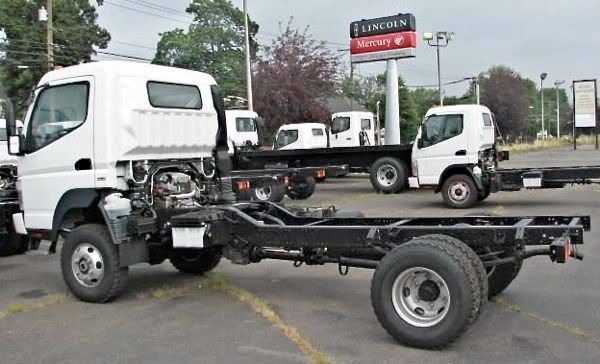Chip,
That is a great photo for showing the differences between the frames on the two models.
Step Down Frame
I'm not an engineer, but from what I can see from ours, unless Mitsubishi Fuso significantly changes the design of the transfer case and front suspension we are likely to continue to see a step down frame on the FG.
The FG's step down frame can be an advantage, depending on your design.
1. The step down section enables an easy frame extension. Grind off the rivets that connect it to the straight frame section, fabricate and install the extension, put in proper grade bolts, get a lengthened intermediate section drive shaft, have a muffler shop fabricate a longer exhaust pipe section, insert an extension in one wiring loom and you have a frame of any length you need.
2. If you choose to implement a 3 point pivot sub-frame that pivots in the rear you can end up with a flat frame from cab to rear. Attach the front of the pivot frame in the forward section of the stepped down frame so its top lines up with the upper section of the step frame. Establish your rear pivot height to maintain the flat frame. Success depends on how tall your sub-frame section is and how much pivot you allow before you hit the bump stops.
Automatic vs. Manual engine output
Another major difference between the two platforms is starting with the FE series redesign a few years ago there has been no automatic transmission available in the FG.
There is a significant difference in output ratings between the 4M50T7 motors used in the manual transmission FE and FGs and the 4M50T8 used in the automatic FEs.
4M50T7: 147 HP @2700; 347 Ft/Lbs @ 1600
4M50T8: 175 HP @2700; 391 Ft/Lbs @ 1600
Click here for the relevent Fuso documentation: http://www.hackneys.com/mitsu/docs/fuso-power-train.pdf
I talked with two different Fuso service managers and two different Fuso parts managers. All four stated there were no differences in camshafts, valves, heads, fuel pumps, injectors, fuel rails, etc. between the T7 and T8. The only part number difference between the two motors is the EFI control unit.
It seemed to me that this could possibly be an easy chip swap between the two EFI controllers, but I did not take on the project of researching, procuring and testing the T8 chip or EFI controller.
One of the Fuso service managers talked with his Fuso factory rep and was told the T7 motor was downrated due to torque capacity limitations of the manual transmission. I have no reason to dispute this but thought it more likely the T8 was uprated to compensate for the torque losses inherent in an automatic transmission's torque converter, thus yielding similar driveshaft power from both drivetrains.
Doug


